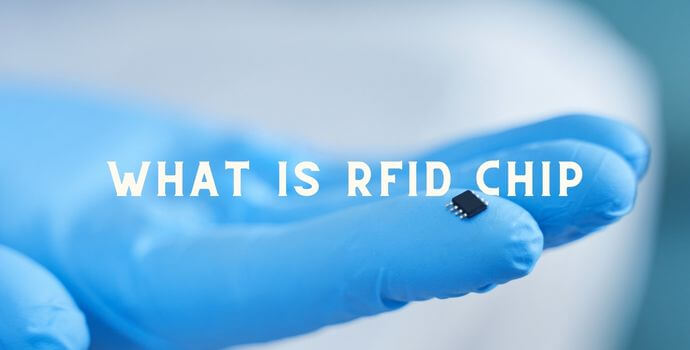If you want to fathom RFID chips, you first need to understand what RFID is. RFID stands for Radio-Frequency Identification.
So, an RFID chip is a Radio-Frequency Identification chip. They store information that can be transferred to an RFID reader wirelessly.
The information is stored in the form of an electronic product code (EPC). EPCs are unique to each product and contain data such as the manufacturing date, batch number, and location. Here, we will discuss RFID chips in detail.
What is an RFID Chip?
An RFID chip is the smallest part of an RFID system. It can measure 0.4 x 0.4 millimeters or even 0.05 x 0.05 millimeters! The chip is made up of an integrated circuit that stores the EPC data.
However, an RFID chip alone cannot work. It must be part of a system comprising these other parts:
- An Antenna. This is used to capture the energy from the RFID reader and power the chip.
- A Substrate. This is a supporting base material on which the antenna and chip are placed.
Due to their small size, RFID chips are often embedded in other objects. For example, they can be injected into livestock during the branding process. They can also be customized to be incorporated into products like furniture or clothes.
How do RFID Chips Look Like?
RFID chips are made of silicon and other materials. They have a unique structure that allows them to store data. The data is stored in the form of an EPC.
EPCs are made up of a series of numbers and letters. Each EPC is unique to a particular product. RFID chips also have a memory area where other data can be stored, such as the date of manufacture, batch number, and location.
The size of an RFID chip can vary, with the smallest recorded chip being 0.05 x 0.05 millimeters. The chips are often embedded in other objects such as livestock, products, or clothes.
If you open up an RFID chip, you don’t expect to see anything special other than a small piece of silicon. But the way RFID chips are made is quite fascinating.
How are RFID Chips Made?
RFID chips are made using a process called photolithography. This is where a silicon wafer is coated with a light-sensitive material. A mask is then used to block certain areas of the wafer.
The exposed areas are then exposed to ultraviolet light, which causes them to harden. The remaining areas are washed away, leaving behind a negative image of the desired design.
This process is repeated multiple times to create layered circuits on the wafer. Once the desired design is completed, the wafer is cut into small chips.
How do RFID Chips Work?
RFID chips work wirelessly. They use radio waves to communicate with an RFID reader. The reader captures the data stored on the chip and sends it to a computer for processing.
The range of an RFID chip varies depending on the frequency used. Low-frequency chips have a range of up to 10 centimeters, while high-frequency chips can have a range of up to one meter.
The data stored on an RFID chip can be read, written, or erased. This is done using an RFID reader. The reader sends a radio signal to the chip, which powers it up. The chip then sends the data stored on it back to the reader.
The data is then processed by a computer. The computer can add, delete, or change the data on the chip.
Types of RFID Chips
There are two main types of RFID chips:
- Active RFID Chips. These RFID chips are always excited and ready to release data. They are part of active RFID tags that contain a battery powering the chip. The battery gives the tag a larger range, typically up to 100 meters.
- Passive RFID Chips. These RFID chips are only powered when they are excited by radio waves from an RFID reader. They do not have a power source of their own and rely on the reader to supply power. Passive RFID tags have a shorter range than active RFID tags, typically up to 10 meters.
RFID chips can also be classified by the frequency they use:
- Low-Frequency RFID Chips. These RFID chips operate at 125 kHz or 134 kHz. They have a short-range and are used for access control and animal identification.
- High-Frequency RFID Chips. These RFID chips operate from 860 MHz to 960 MHz. They have a medium-range and are used in supply chain management and contactless payments.
- Ultra-High-Frequency RFID Chips. These RFID chips operate at 2.45 GHz. They have a long range and are used for tracking vehicles and aircraft.
When choosing an RFID chip, you need to consider the frequency, range, and power requirements of your application. Also, ensure that you understand the functions.
For example, LF RFID chips can work in any environment, including liquid and metallic. This makes them ideal for animal identification. UHF RFID chips, on the other hand, are better suited for supply chain management as they can be read from a distance.
Applications of RFID Chips
You can use RFID chips for multiple applications. Some common uses include:
- Tracking Livestock
RFID tags for livestock are typically injected into the animal’s skin. The tag contains information about the animal, including its breed, age, and gender.
This information is used to track the animal’s movements and monitor its health. RFID tags are also used to identify animals that have been stolen or strayed from their owner.
- Tracking Products
RFID tags are used to track products throughout the supply chain. The tags are attached to products at the manufacturing stage. They are then used to track the movement of the products as they are shipped and stored.
The data on the tags can be used to monitor the progress of an order, track inventory, and prevent fraud.
- Identifying People
RFID tags are used to identify people in a variety of settings. For example, they are used to track the movement of employees in a company. They can also be used to grant access to buildings or other areas.
RFID tags are also being used in passports and other travel documents. The data on the tags can be used to verify the identity of the holder and prevent fraud.


